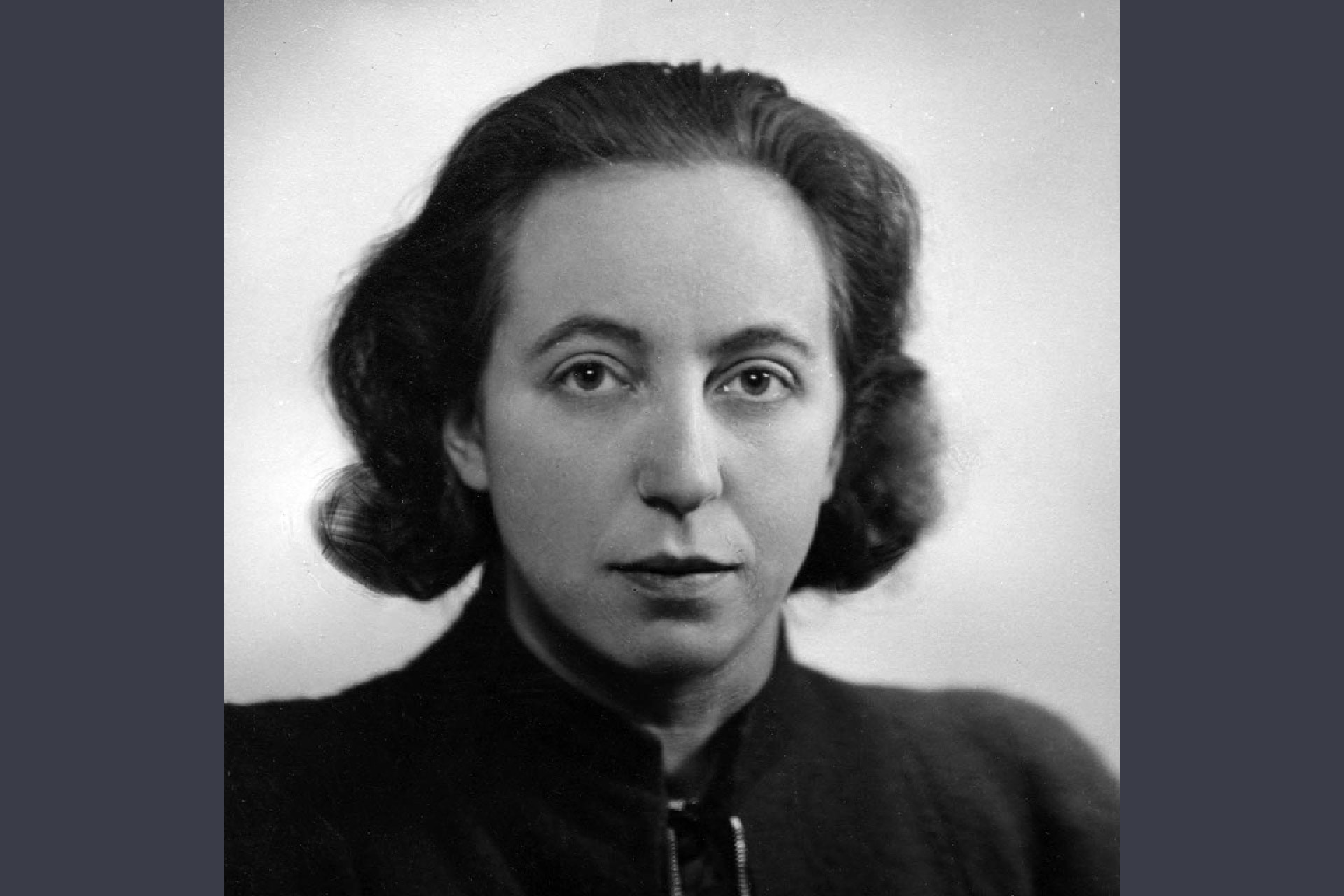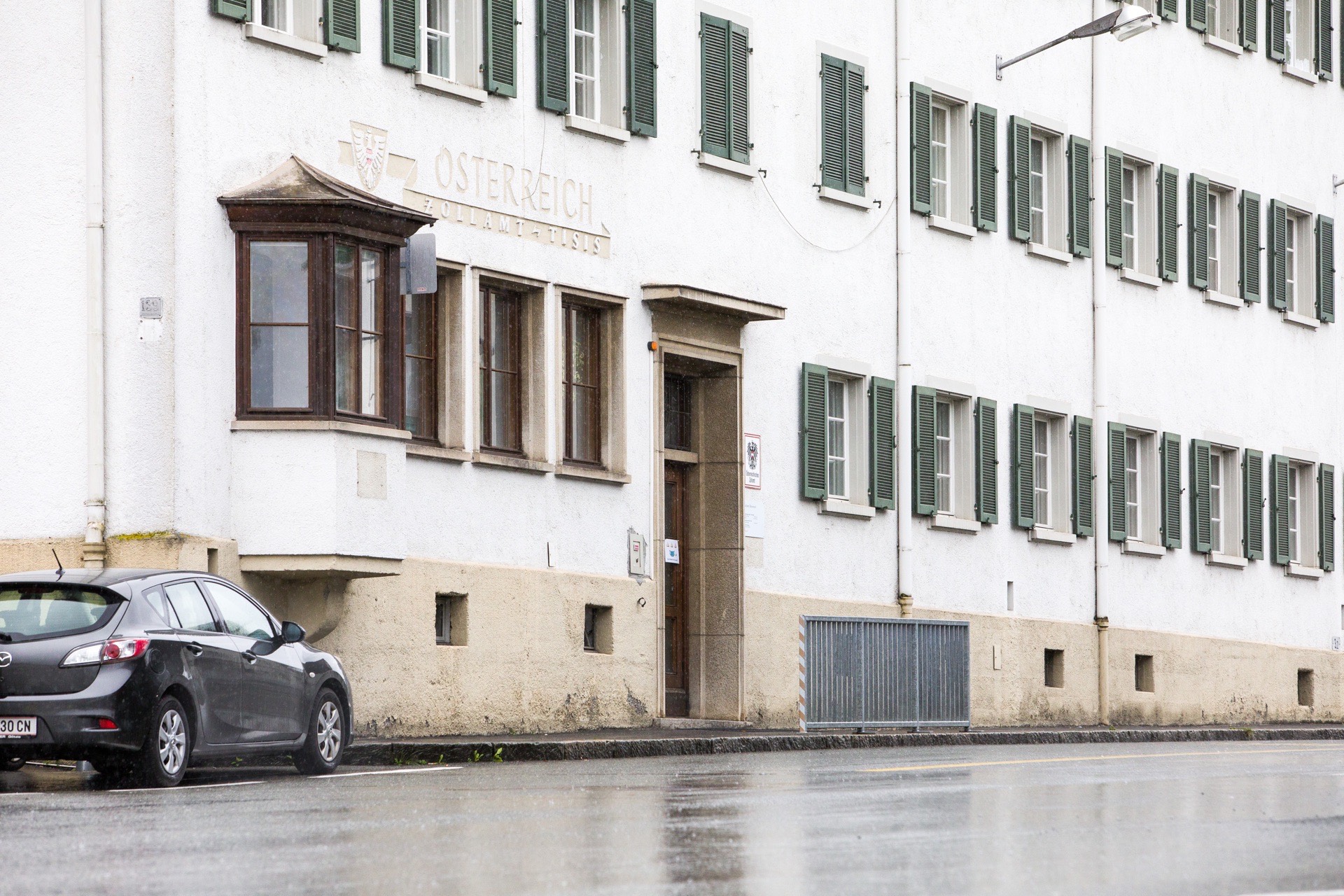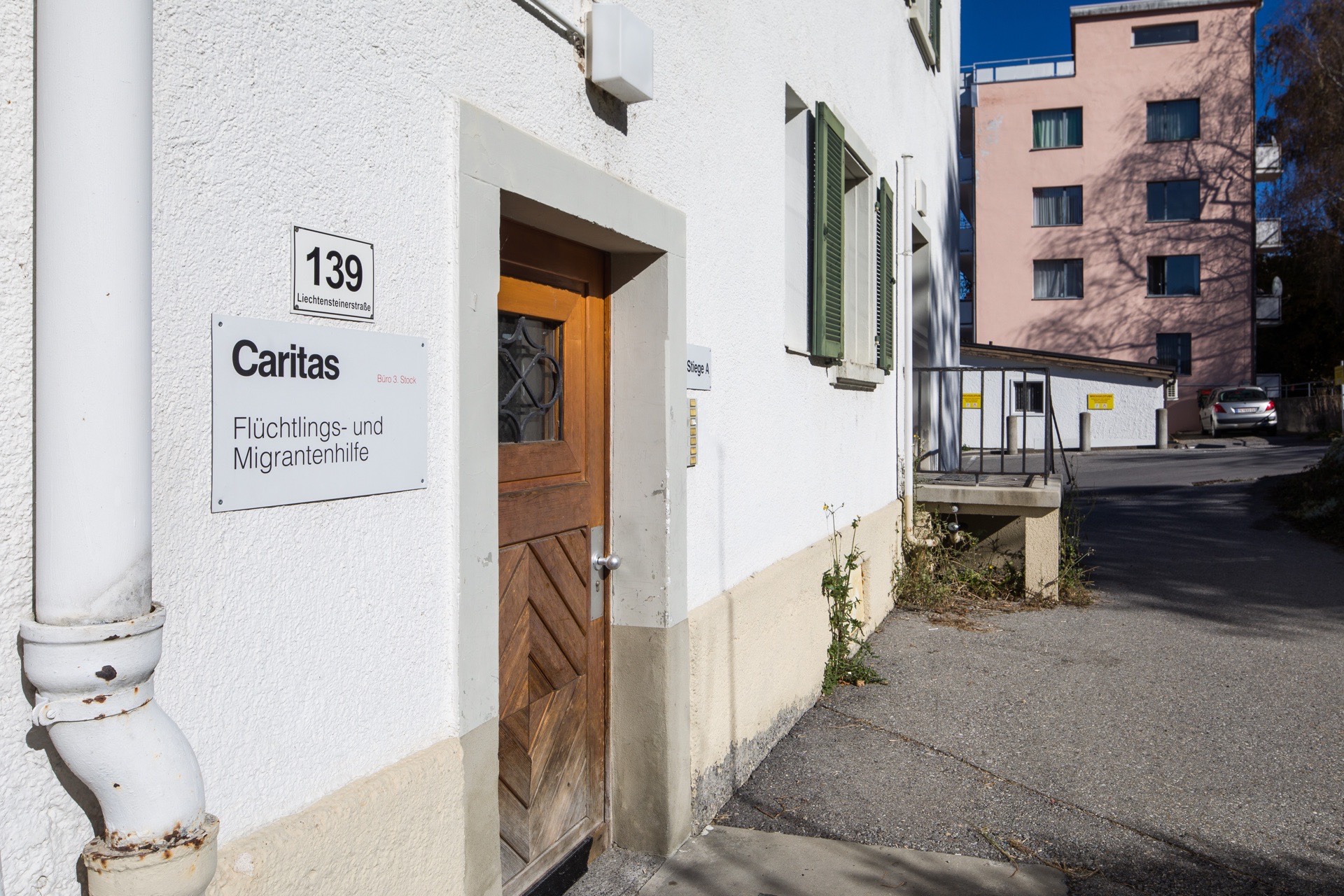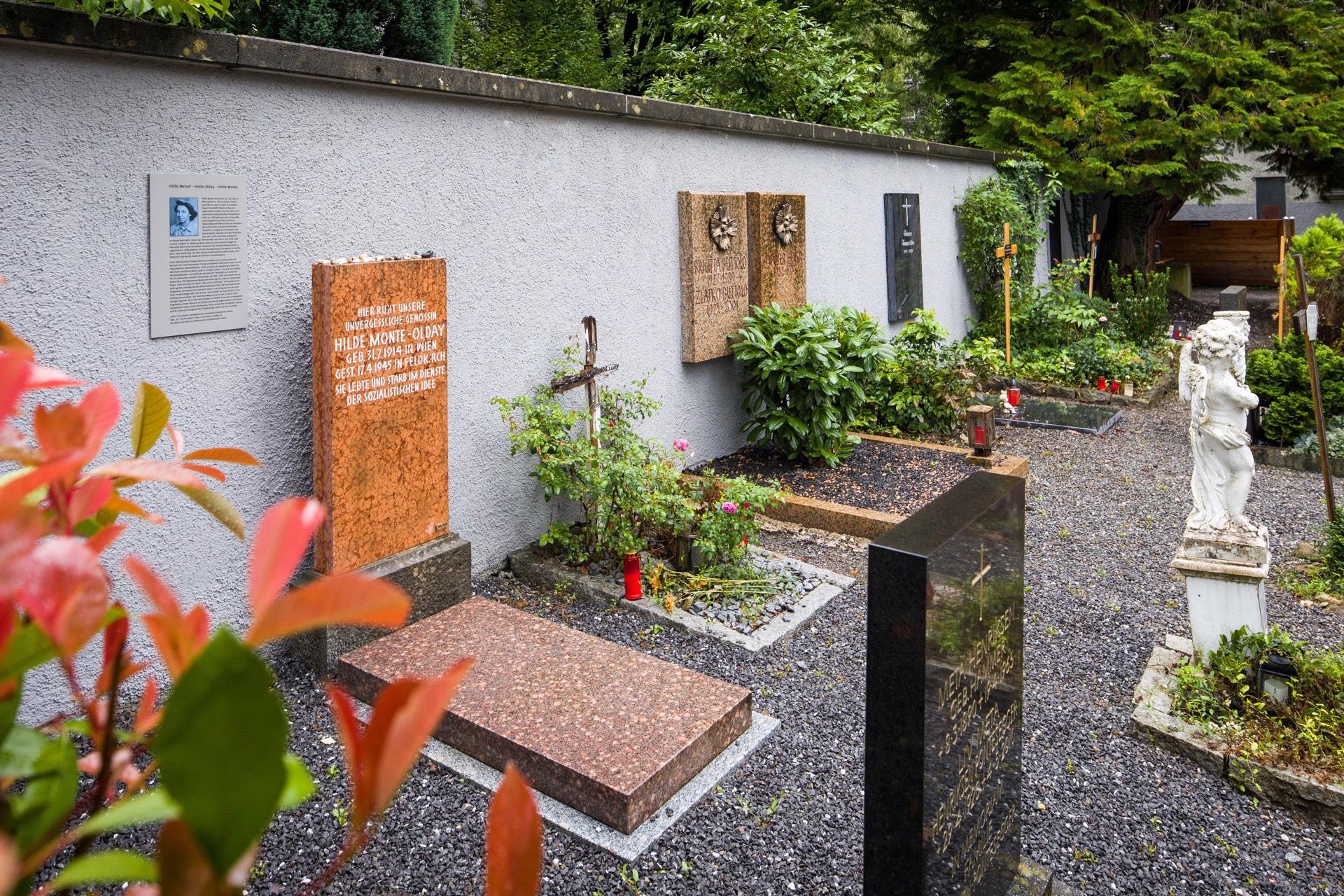Hilda Monte> April 17, 1945
37 Hilda Monte
“The Unity of Europe” A few days before the end of the war, the resistance fighter Hilda Monte dies at the border crossing at Tisis
Feldkirch, April 17, 1945
On April 18, 1945, the Innsbruck criminal police, branch office Feldkirch, reports to the Mayor of the City of Feldkirch:
“Concerning Schneider, Eva, office clerk, born June 30, 1913 in Bromberg, last address Berlin, Helmstetterstr. 24. Death by use of arms on April 17, 1945.
Reference: none
On April 17, 1945 around 6:30 a.m., the above-mentioned was so severely injured by the customs border guards of the Tisis border post following her earlier arrest at 3:45 a.m. in Rappenwald/Tisis due to attempted border crossing—as she was taking flight trying to escape toward the border of the Reich—from a shot in her right thigh that she soon passed away from internal bleeding. The corpse was carried to the Liebfrauenkirche {Church of Our Lady} in Feldkirch and examined there by the public medical officer Dr. Müller and the municipal physician Dr. Pontesegger and cleared by the Feldkirch public prosecutor’s office for interment following clarification of the facts of the case.A substantial amount of money was found in her possessions with which the burial costs can be defrayed. The Feldkirch registry office has received a death notice from our office.”[1]
Eva Schneider, the woman who was shot while trying to escape across the border, was in fact the socialist resistance fighter Hilde Meisel-Olday. As an author of poems, novellas, but above all political essays, radio broadcasts and political programs and books, she went by the name of Hilda Monte.
In 1914, she was born in Vienna into a Jewish family – but already in 1915 her parents moved with her and her older sister Margot to Berlin, where her father opened an import-export business. While still a teenager, she joined the International Socialist Fighting League (ISK). In 1929, she travelled to England for the first time to visit her uncle, the successful composer Edmund Meisel, whose film scores are legendary to this day. In 1932 she went to Paris. She regularly published analyses of the political and economic situation in England, France and Germany, Spain, and the colonies. She spent the years 1933 and 1934 in the German Reich before emigrating again to Paris in 1934 and to London in 1936. Several times thereafter she continued to travel illegally to the German Reich, helping to organize workers' resistance actions. In 1938, in order to prevent her expulsion from England, she entered into a marriage of convenience with the German-British cartoonist John Olday and thus became a British citizen.
During the war, she remained involved in a wide variety of resistance activities, whether as a courier for the International Transport Workers' Federation, or on behalf of Allied intelligence services. In 1940, her book “How to conquer Hitler,” co-authored with Fritz Eberhard, was published. She was involved in setting up the radio station “of the European Revolution,” and worked regularly for the BBC's German workers broadcasts. In 1942, she gave a shocking report on the radio about the mass extermination of Jews that had begun in occupied Poland. In 1943 her book “The Unity of Europe” was published and in 1944 she went to occupied France on behalf of the American secret service OSS and Austrian socialists; then to Switzerland; and in April 1945 again illegally crossed the border to make contact with socialists in Vorarlberg.
Barely more than two weeks before French troops reach Feldkirch and the war in the Vorarlberg Rhine Valley is over, her life ends by force at the border near Tisis. Early in the morning of April 17, 1945, she is apprehended in Rappenwald on the border with Liechtenstein.
For two hours she is held in the customs office, then in the early morning hours she tries to escape. That is when the fatal shot is fired. The dead woman is thought to be a Protestant and is buried in the Protestant cemetery.
After liberation, news of her death reaches her friends in Switzerland and England - and her family in Palestine and Egypt. Austrian socialists place a stone on her grave at the Protestant cemetery with the inscription: "Here rests our unforgettable comrade Hilde Monte-Olday. Born 31.7.1914 in Vienna. Died 17.4.1945 in Feldkirch. She lived and died in the service of the socialist idea".

"I can only define myself as a European, but I guess that we have not reached the stage where that is permissble." Letter from Hilda Monte to the International Socialist Forum, May 30, 1943.
Archive of Andreas Wilkens, Paris
 Liechtenstein border near Mauren, 1945
Liechtenstein border near Mauren, 1945
Liechtensteiner Landesarchiv, Vaduz
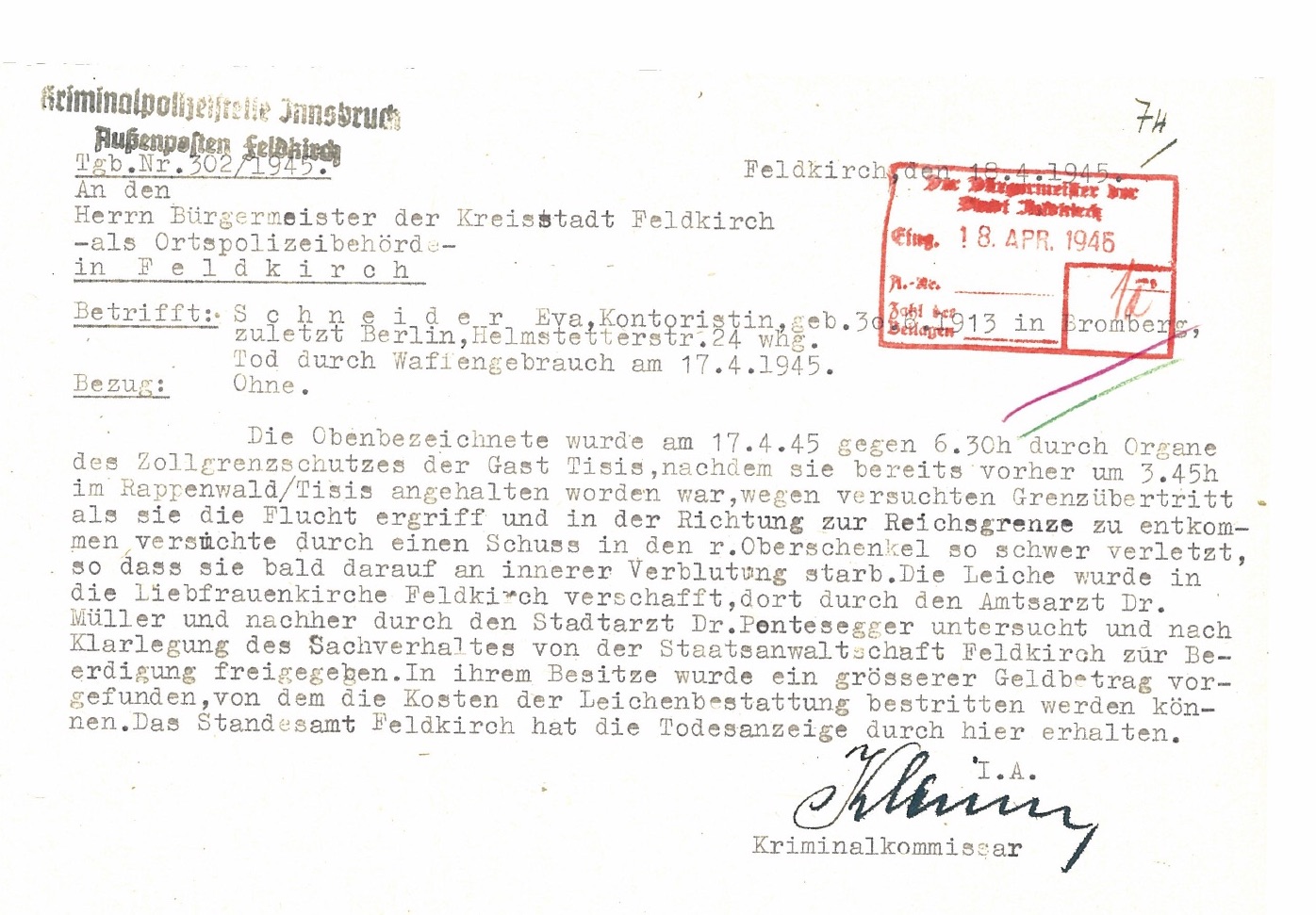
Report to the criminal police headquarter Innsbruck, 17.4.1945
Archive of the Jewish Museum Hohenems
37 Hilda Monte
“The Unity of Europe” A few days before the end of the war, the resistance fighter Hilda Monte dies at the border crossing at Tisis
Feldkirch, April 17, 1945
On April 18, 1945, the Innsbruck criminal police, branch office Feldkirch, reports to the Mayor of the City of Feldkirch:
“Concerning Schneider, Eva, office clerk, born June 30, 1913 in Bromberg, last address Berlin, Helmstetterstr. 24. Death by use of arms on April 17, 1945.
Reference: none
On April 17, 1945 around 6:30 a.m., the above-mentioned was so severely injured by the customs border guards of the Tisis border post following her earlier arrest at 3:45 a.m. in Rappenwald/Tisis due to attempted border crossing—as she was taking flight trying to escape toward the border of the Reich—from a shot in her right thigh that she soon passed away from internal bleeding. The corpse was carried to the Liebfrauenkirche {Church of Our Lady} in Feldkirch and examined there by the public medical officer Dr. Müller and the municipal physician Dr. Pontesegger and cleared by the Feldkirch public prosecutor’s office for interment following clarification of the facts of the case.A substantial amount of money was found in her possessions with which the burial costs can be defrayed. The Feldkirch registry office has received a death notice from our office.”[1]
Eva Schneider, the woman who was shot while trying to escape across the border, was in fact the socialist resistance fighter Hilde Meisel-Olday. As an author of poems, novellas, but above all political essays, radio broadcasts and political programs and books, she went by the name of Hilda Monte.
In 1914, she was born in Vienna into a Jewish family – but already in 1915 her parents moved with her and her older sister Margot to Berlin, where her father opened an import-export business. While still a teenager, she joined the International Socialist Fighting League (ISK). In 1929, she travelled to England for the first time to visit her uncle, the successful composer Edmund Meisel, whose film scores are legendary to this day. In 1932 she went to Paris. She regularly published analyses of the political and economic situation in England, France and Germany, Spain, and the colonies. She spent the years 1933 and 1934 in the German Reich before emigrating again to Paris in 1934 and to London in 1936. Several times thereafter she continued to travel illegally to the German Reich, helping to organize workers' resistance actions. In 1938, in order to prevent her expulsion from England, she entered into a marriage of convenience with the German-British cartoonist John Olday and thus became a British citizen.
During the war, she remained involved in a wide variety of resistance activities, whether as a courier for the International Transport Workers' Federation, or on behalf of Allied intelligence services. In 1940, her book “How to conquer Hitler,” co-authored with Fritz Eberhard, was published. She was involved in setting up the radio station “of the European Revolution,” and worked regularly for the BBC's German workers broadcasts. In 1942, she gave a shocking report on the radio about the mass extermination of Jews that had begun in occupied Poland. In 1943 her book “The Unity of Europe” was published and in 1944 she went to occupied France on behalf of the American secret service OSS and Austrian socialists; then to Switzerland; and in April 1945 again illegally crossed the border to make contact with socialists in Vorarlberg.
Barely more than two weeks before French troops reach Feldkirch and the war in the Vorarlberg Rhine Valley is over, her life ends by force at the border near Tisis. Early in the morning of April 17, 1945, she is apprehended in Rappenwald on the border with Liechtenstein.
For two hours she is held in the customs office, then in the early morning hours she tries to escape. That is when the fatal shot is fired. The dead woman is thought to be a Protestant and is buried in the Protestant cemetery.
After liberation, news of her death reaches her friends in Switzerland and England - and her family in Palestine and Egypt. Austrian socialists place a stone on her grave at the Protestant cemetery with the inscription: "Here rests our unforgettable comrade Hilde Monte-Olday. Born 31.7.1914 in Vienna. Died 17.4.1945 in Feldkirch. She lived and died in the service of the socialist idea".

"I can only define myself as a European, but I guess that we have not reached the stage where that is permissble." Letter from Hilda Monte to the International Socialist Forum, May 30, 1943.
Archive of Andreas Wilkens, Paris
 Liechtenstein border near Mauren, 1945
Liechtenstein border near Mauren, 1945
Liechtensteiner Landesarchiv, Vaduz



